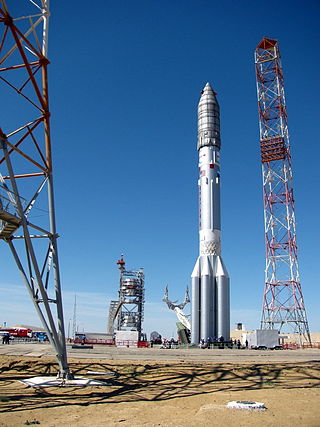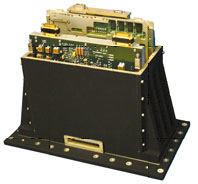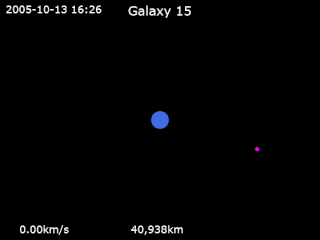Related Research Articles

Ariane 5 is a European heavy-lift space launch vehicle developed and operated by Arianespace for the European Space Agency (ESA). It is launched from the Centre Spatial Guyanais (CSG) in French Guiana. It has been used to deliver payloads into geostationary transfer orbit (GTO) or low Earth orbit (LEO). The launch vehicle had a streak of 82 consecutive successful launches between 9 April 2003 and 12 December 2017. Since 2014, Ariane 6, a direct successor system, is in development.

Intelsat S.A. is a multinational satellite services provider with corporate headquarters in Luxembourg and administrative headquarters in Tysons Corner, Virginia, United States. Originally formed as International Telecommunications Satellite Organization, from 1964 to 2001, it was an intergovernmental consortium owning and managing a constellation of communications satellites providing international telecommunications and broadcast services.
Iridium Communications Inc. is a publicly traded American company headquartered in McLean, Virginia. Iridium operates the Iridium satellite constellation, a system of 66 active satellites and 9 in-orbit spares used for worldwide voice and data communication from hand-held satellite phones and other transceiver units. The nearly polar orbit and communication between satellites via inter-satellite links provide global service availability.

Proton is an expendable launch system used for both commercial and Russian government space launches. The first Proton rocket was launched in 1965. Modern versions of the launch system are still in use as of 2022, making it one of the most successful heavy boosters in the history of spaceflight. The components of all Protons are manufactured at the Khrunichev State Research and Production Space Center factory in Moscow and Chemical Automatics Design Bureau in Voronezh, then transported to the Baikonur Cosmodrome, where they are assembled at Site 91 to form the launch vehicle. Following payload integration, the rocket is then brought to the launch pad horizontally by rail, and raised into vertical position for launch.

A military satellite is an artificial satellite used for a military purpose. The most common missions are intelligence gathering, navigation and military communications.
Orbital Sciences Corporation was an American company specializing in the design, manufacture, and launch of small- and medium- class space and launch vehicle systems for commercial, military and other government customers. In 2014, Orbital merged with Alliant Techsystems to create a new company called Orbital ATK, Inc., which in turn was purchased by Northrop Grumman in 2018. The remnants of the former Orbital Sciences Corporation today are a subsidiary of Northrop Grumman, known as Northrop Grumman Innovation Systems.

SES S.A. is a Luxembourgish-French satellite telecommunications network provider supplying video and data connectivity worldwide to broadcasters, content and internet service providers, mobile and fixed network operators, governments and institutions.
ORBCOMM is an American company that offers industrial Internet of things (IoT) and machine to machine (M2M) communications hardware, software and services designed to track, monitor, and control fixed and mobile assets in markets including transportation, heavy equipment, maritime, oil and gas, utilities and government. The company provides hardware devices, modems, web applications, and data services delivered over multiple satellite and cellular networks.

Commercial use of space is the provision of goods or services of commercial value by using equipment sent into Earth orbit or outer space. This phenomenon – aka Space Economy – is accelerating cross-sector innovation processes combining the most advanced space and digital technologies to develop a broad portfolio of space-based services. The use of space technologies and of the data they collect, combined with the most advanced enabling digital technologies is generating a multitude of business opportunities that include the development of new products and services all the way to the creation of new business models, and the reconfiguration of value networks and relationships between companies. If well leveraged such technology and business opportunities can contribute to the creation of tangible and intangible value, through new forms and sources of revenue, operating efficiency and the start of new projects leading to multidimensional positive impact. Examples of the commercial use of space include satellite navigation, satellite television and commercial satellite imagery. Operators of such services typically contract the manufacturing of satellites and their launch to private or public companies, which form an integral part of the space economy. Some commercial ventures have long-term plans to exploit natural resources originating outside Earth, for example asteroid mining. Space tourism, currently an exceptional activity, could also be an area of future growth, as new businesses strive to reduce the costs and risks of human spaceflight.

SpaceQuest, Ltd. is a spacecraft components and engineering company located in Fairfax, Virginia, which focuses on the operations of small satellites.

The Proton-M, (Протон-М) GRAU index 8K82M or 8K82KM, is an expendable Russian heavy-lift launch vehicle derived from the Soviet-developed Proton. It is built by Khrunichev, and launched from sites 81 and 200 at the Baikonur Cosmodrome in Kazakhstan. Commercial launches are marketed by International Launch Services (ILS), and generally use Site 200/39. The first Proton-M launch occurred on 7 April 2001.

Advanced Extremely High Frequency (AEHF) is a constellation of communications satellites operated by the United States Space Force. They are used to relay secure communications for the United States Armed Forces, the British Armed Forces, the Canadian Armed Forces, the Netherlands Armed Forces and the Australian Defence Force. The system consists of six satellites in geostationary orbits. The final satellite was launched on 26 March 2020. AEHF is backward compatible with, and replaces, the older Milstar system and will operate at 44 GHz uplink and 20 GHz downlink. The AEHF system is a joint service communications system that provides survivable, global, secure, protected, and jam-resistant communications for high-priority military ground, sea and air assets.
Marisat satellites were the first maritime telecommunications satellites and were designed to provide dependable telecommunications for commercial shipping and the U.S. Navy from stable geosynchronous orbital locations over the three major ocean regions. The three Marisat satellites, F1, F2, and F3, were built by Hughes Aircraft Corporation (HAC) for COMSAT Corporation starting in 1973. The satellites were designed to provide maritime telecommunications services in three large ocean areas, the Atlantic Ocean, the Pacific Ocean, and the Indian Ocean, and were located at 72.5° East longitude, 176.5° E, and 345° E in the geosynchronous orbital arc. The three-satellite Marisat system served as the initial INMARSAT constellation.

The Iridium satellite constellation provides L band voice and data information coverage to satellite phones, pagers and integrated transceivers over the entire surface of Earth. Iridium Communications owns and operates the constellation, additionally selling equipment and access to its services. It was conceived by Bary Bertiger, Raymond J. Leopold and Ken Peterson in late 1987 and then developed by Motorola on a fixed-price contract from July 29, 1993, to November 1, 1998, when the system became operational and commercially available.

Internet Routing in Space (IRIS) was a program to build a radiation-tolerant IP router created by Cisco Systems for satellite and related spacecraft. It was a follow-on from Cisco's earlier CLEO router in space on the UK-DMC satellite. The Cisco Space Router was launched to geostationary orbit on board Intelsat 14 (IS-14), a spacecraft built by Space Systems/Loral for satellite operator Intelsat, in November 2009. IRIS was evaluated by the United States Department of Defense by way of a JCTD. The Space Router runs Cisco IOS software and also contains an onboard Software-defined radio running satellite modem waveforms. The United States Department of Defense used the JCTD to evaluate the reduced latency, improved throughput and increased flexibility provided by the Space Router.

Galaxy 15 is an American telecommunications satellite which is owned by Intelsat. It was launched for and originally operated by PanAmSat, and was subsequently transferred to Intelsat when the two companies merged in 2006. It was originally positioned in geostationary orbit at a longitude of 133° West, from where it was used to provide communication services to North America.
Space Infrastructure Servicing (SIS) is a spacecraft concept being developed by Canadian aerospace firm MDA to operate as a small-scale in-space refueling depot for communication satellites in geosynchronous orbit.

A space tug is a type of spacecraft used to transfer spaceborne cargo from one orbit to another orbit with different energy characteristics. An example would be moving a spacecraft from a low Earth orbit (LEO) to a higher-energy orbit like a geostationary transfer orbit, a lunar transfer, or an escape trajectory.
SES-2 is a communications satellite operated by SES World Skies. It was launched alongside the Arabsat-5C satellite.
SES-5 is a commercial geostationary communication satellite operated by SES S.A. It was launched on 9 July 2012. The launch was arranged by International Launch Services (ILS).
References
- ↑ "Hosted Payloads – Office of Space Commerce" . Retrieved 2022-12-20.
- ↑ "What is a Hosted Payload?". Iridium Satellite Communications. 2018-08-21. Retrieved 2022-12-20.
- ↑ Office, U. S. Government Accountability. "Military Space Systems: DOD's Use of Commercial Satellites to Host Defense Payloads Would Benefit from Centralizing Data". www.gao.gov. Retrieved 2022-12-20.
- ↑ Meyerson, Hilary (2020-12-04). "Hosted Payloads Hitchhike to Space with Spaceflight's Sherpa OTVs". Spaceflight. Retrieved 2022-09-30.
- ↑ "Developments in hosted payloads" (PDF). Global Military Communications Magazine. 2018. Retrieved 2022-09-30.
- ↑ Space News
- ↑ "Government Solutions".
- ↑ Space News
- ↑ "DoD, Australia Sharing Hosted UHF Payload Space On Intelsat 22 Satellite". Defense Daily. 2012-03-30. Retrieved 2022-10-27.
- ↑ Andy Pasztor and Nathan Hodge (February 11, 2011). "Space Projects of Pentagon to Get Boost". The Wall Street Journal. Retrieved August 22, 2013.
- ↑ U.S. Air Force, SAIC, SES, and Orbital launch Commercially Hosted Infrared Payload Sensor infrared staring system aboard SES-2 satellite Military & Aerospace Electronics September 24, 2011. Accessed May 29, 2018
- ↑ "Iridium NEXT | Hosted Payloads". www.iridium.com. Archived from the original on 2010-03-04.
- ↑ GOLD NASA mission website. Accessed May 29, 2018
- ↑ SES-14 - Accompanying the opportunities in high growth markets in the Americas and North Atlantic SES. Accessed May 29, 2018
- ↑ ASTRA 5B's mission SES website. Accessed April 28, 2018
- ↑ SES-5 GEO Satellite Ensures EGNOS Services for the Long Term European Global Navigation Satellite Systems Agency September 4, 2015. Accessed May 29, 2018
- ↑ EGNOS on SES website SES. Accessed May 29, 2018
- ↑ Leidos bests Raytheon for FAA hosted payload contract Space News April 9, 2018. Accessed May 29, 2018
- ↑ New WAAS GEO Satellite Launch Federal Aviation Administration SatNavNews newsletter Spring 2017. Accessed May 29, 2018